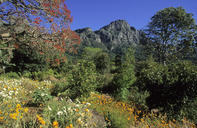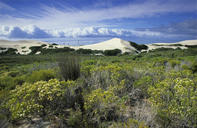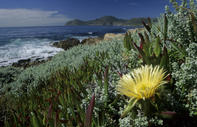The Smallest Botanical Kingdom
The Cape Floral Kingdom is the smallest of all the botanical kingdoms and the only one to occur entirely on a single continent. It is swept into the bottom south-western edge of the African continent and covers an area as small as the size of Portugal. It has 8 600 species of plants of which 5 800 occur nowhere else in the world.

Spread over less than 0.04 percent of the Earth's land surface, the Cape Floral Kingdom has 0.7 percent of its endemic plant diversity. The Cape Peninsula alone, which is smaller than the city of London, has more flowering plants than the entire British Isles. This is a collection of plants so extraordinarily rare and unique that they are a wonder of the natural world.
Crammed into the toe of the continent like a thin inner sole, the Cape Floral Kingdom forms a 200 km wide band running along about 1 000 km from Clanwilliam (just inland of the West Coast) to Humansdorp (near Port Elizabeth).
The bulk of its residents are a collection of shrub-like plants known as fynbos, so named by early Dutch settlers who were not entirely enamoured with the fijnbosch (literally 'fine bush') offered by their new home. Where the settlers needed constructive timber and firewood, instead they found the extravagantly frivolous embroidery of the Cape.
Fynbos Paradise

Fynbos accounts for 80 percent of the Cape Floral Kingdom's species, constituting four-fifths of the total area, while the rest of the region is covered with small patches of succulent karoo, thicket, renosterveld and afromontane forest. Fynbos seems terribly drab at first sight, like a dull throw of mute green-grey, barely noticeable against the more majestic cliffs and peaks of the Cape Fold Mountains that it drapes. Distance does fynbos a disservice.
To really appreciate the stuff, you need to be tripping over it. That's when you find an extraordinary weave of filigreed leaves, sprays of reeds and heady-scented flowers. Little shrubs made of the finest lacework, wiry and lean like a dancer.
Frizzy pincushions; bell-like petals; riotously unrestrained lilies and orchids of the most delicate design; silver leaves shimmering in the wind and the strangely masculine protea flowers with their woody petals and bearded stamen. In the right season fynbos dances with eager pollinators. Game spotting is in miniature: bugs, birds, the finest reptiles and rare frogs.
Flora Fixture

Some plants are so rare that they occur on a single plain on the Knersvlakte or hidden away in a little kloof somewhere on the Cape Peninsula. In these cases, one poorly-considered housing development or a single block of Sauvignon Blanc vineyard could bring about a full-scale extinction.
As a result of this high level of 'endemism', many of the Kingdom's plants are threatened with extinction, mostly in the face of spreading agriculture, housing and alien vegetation. More than 1400 species are listed as critically rare, endangered or vulnerable; 29 species are already lost from the gene pool forever, and a staggering three-quarters of all the plants featured in South Africa's Red Data Book of threatened species occur in the Cape Floral Kingdom.
If this Kingdom were a haberdashery, then fynbos would be a priceless bolt of cloth. The sheer number and variety of its heath-like plants, protea shrubs, reeds and flowering bulb plants make a tight weave for one of the most richly unique plant communities on the planet.
By Leonie Joubert